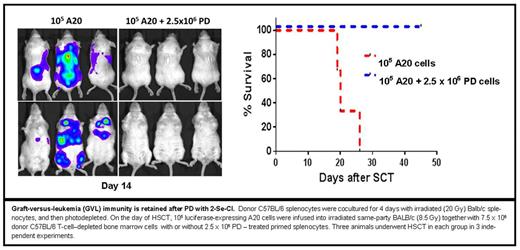Abstract
Immune effector cell therapy is a potent form of cancer treatment with a high curative potential for certain human malignancies. Yet, the success of current approaches is offset by associated toxicities, including acute graft-versus-host-disease (GVHD). In the allogeneic setting, GVHD is caused by an attack on the recipient's tissues by donor T cells. Ex vivo application of phototherapy to selectively deplete GVHD-causing cells prior to transplant may prevent GVHD. However, none of the photosensitive agents in use today have demonstrated selectivity without significant toxicity occurring in resting cells. We have designed the first-in-class photosensitizer 2-Se-Cl with the ability to accumulate in alloreactive T cells in proportion to degree of oxidative phosphorylation. Unique to 2-Se-Cl is the ability to potently stimulate P-glycoprotein (P-pg). Enhanced P-gp activity promotes the efficient removal of photosensitizer not sequestered in mitochondria, and protects resting lymphocytes essential for antipathogen and antitumor responses. We have previous demonstrated the ex vivo photodepletion of alloreactive T cell using 2-Se-Cl successfully prevented GVHD in a lethal model of the disease with full retention of antipathogen immunity and 3rd party responses. To evaluate for the retention of antitumor immunity after photodepletion with 2-Se-Cl, a well-established complete MHC antigen-mismatched murine model of hematopoietic stem cell transplant (HSCT) was employed. To prepare the cells for photodepletion, donor C57BL/6 splenocytes were cocultured for 4 days with irradiated (20 Gy) Balb/c splenocytes, and then photodepleted (PD) with 2-Se-Cl. On the day of HSCT, recipient Balb/c mice were irradiated with 8.5Gy, and received 7.5 x106 T cell-depleted (TCD) C57BL/6-derived bone marrow cells accompanied by 2.5 x106 PD - treated cells, or 105 recipient-derived (A20, Balb/c-derived) leukemia cells (engineered to express firefly luciferase), or both. To evaluate for the retention of 3rd party responses, C3H/HeJ were irradiated (9.5 Gy) and received a combination of 7.5 x106 TCD C57BL/6-derived bone marrow cells accompanied by 2.5 x106 PD - treated cells. All mice were monitored for signs of GVHD according to a well-established mouse GVHD grading system. Three animals underwent HSCT in each group in 3 independent experiments. Recipient Balb/c mice that received PD-treated splenocytes survived > 45 days without evidence of GVHD or leukemia, equivalent to controls (recipients of TCD bone marrow cells only). In contrast, mice that were inoculated with leukemia at time of HSCT without the addition of PD-treated splenocytes died of leukemia progression (see figure). Additionally, all third-party C3H/HeJ mice that received the same number of PD-treated cells died of lethal GVHD, consistent with the selective depletion of the alloimmune response towards BalB/c by 2-Se-Cl. These results demonstrate that ex vivo application of 2-Se-Cl protects against lethal GVHD while maintaining antitumor immunity. The high selectivity of this novel photosensitizer may have broad applications, including the rapid production of immune effector cell products with potent antitumor activity and a low potential for toxicity.
No relevant conflicts of interest to declare.
Author notes
Asterisk with author names denotes non-ASH members.


